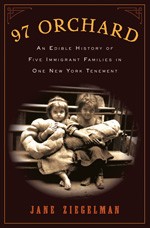 Orchard Street in the heart of the Lower East Side between Stanton and Hester is now home to some of NYC’s trendiest. Although vibrant and fun, I’m not in love with all contemporary New York has to offer, and the move of Gus’s Pickles (made famous in Crossing Delancey) to Brooklyn is bitter-sweet.
Orchard Street in the heart of the Lower East Side between Stanton and Hester is now home to some of NYC’s trendiest. Although vibrant and fun, I’m not in love with all contemporary New York has to offer, and the move of Gus’s Pickles (made famous in Crossing Delancey) to Brooklyn is bitter-sweet.
However, if you have a special place in your heart for our other easterly Homeland, or a love for delectable food, I encourage you to read 97 Orchard and linger around the intersection of Orchard and Delancey Streets. In these pages you can imagine yourself on a bustling street in 1870 crowded with thousands of people. After all, about 3,000 new immigrants a day were served meals over at Ellis Island. Seeking to fill your basket or pail with radishes, eggs, barley, cabbage, split peas, dill, vinegar, cucumber, parsley, and scallions, you’d be able to hear the geese carrying on from basements and yards, maybe spot a goat watching you from a window, and you’d probably smell the fish long before you found the fish peddler. If you were a member of the German Jewish crowd about to move out of the East Side you might be looking for oysters, but if you were a recent arrival from Russia you were more likely hoping to find the kosher butcher. Either way, a nice fish would do. As Jane Ziegelman invites us,
Our visit with Mrs. Gumpertz begins on a Friday, late morning, over a steaming pot of fish, a carp. The fish lays snugly in an oblong vessel, like a newborn in a watery cradle. From our current vantage point, it looks intact. In reality, however, the fish has been surgically disassembled and reassembled. It is the kind of culinary operation worthy of a trained professional, yet the responsible party is standing in front of us, an ordinary home cook.
So begins the introduction to the first Jewish family in this tenement and an explanation of the history of gefilte fish in Chapter Three of 97 Orchard: An Edible History of Five Immigrant Families in One New York Tenement, by Jane Ziegelman (the director of the Tenement Museum’s forthcoming culinary center) which Smithsonian/HarperCollins sent me in hardcover for this review. Complete with recipes, the hardcover retails for $25.99.
Lest you think, as I did, that bland Jewish food originated with our Ashkenazic ancestors, as Ms. Ziegelman tells it the Red Cross ladies who worked on Orchard Street were particularly dismayed at the spiciness of Jewish cuisine. They had to work hard to convince our grandmothers to give up the strong flavors, the liberal use of vinegar and onions, the radishes, the garlic, the pepper for a more mild and “American” diet. Apparently out of concern for the moral well-being of our children, for whom they feared the ½ and whole sour dill pickle would essentially be the gateway drug to whiskey, those well-meaning women came to the tenement kitchen armed with the more appropriate snack of crackers and milk. Delightfully, what the health workers of the era fought against this book celebrates with juicy descriptions and recipes – some vague (to make dumplings take potatoes, add eggs and flour until workable but not stiff) and some specific like Mrs. Rogarshevsky’s challah recipe (using peanut oil) on p. 157.
I thoroughly enjoyed this book. History, the stories that tell who we were and shape who we are, is as full of flavor as garlic and onion fried dumplings, cherry strudel, and ginger-stuffed pike and 97 Orchard serves up the past with an inviting array of colorful side-dishes.
A historian might appreciate a few more citations. I needed maps of the Lower East Side and Europe (in particular the boundaries of Germany, Russia, and Poland in the late 1800s) to help place street vendors, tenements, and family origins as I read. And if you like to cook, bake, or pickle, I recommend you prepare yourself for the inevitable trip to a farmer’s market or grocery store because you just might want to see for yourself what all of the fuss was about.
If you love a good story and have ever wished you could travel through time, I think you will enjoy 97 Orchard and I recommend it with the enthusiasm of a kid with enough pocket change to buy a pickle.
(Photo: National Archives and Records Administration, Records of the Public Housing Administration)





I loved visiting the Tenement Museum last time I was in NYC. And adding this layer of food makes the history all the richer. Of course, your review made me want to go get the cucumbers off the vine and make some pickles.
I thought it was a fabulous review and something I will have to look for at the library! My husband also writes for TCJ and gets little to no comments. It can be frustrating, but know there are many out there who love to read what you have written!
Sounds like a great book! Can’t wait to go to NYC with you in a couple months!
Liddy – Seriously! I love that “subversive” is as simple as making, buying, or eating pickles! 😉
Amanda – Let me know if you find it in Omaha, and what you think!
Ana – You’re telling me! 🙂